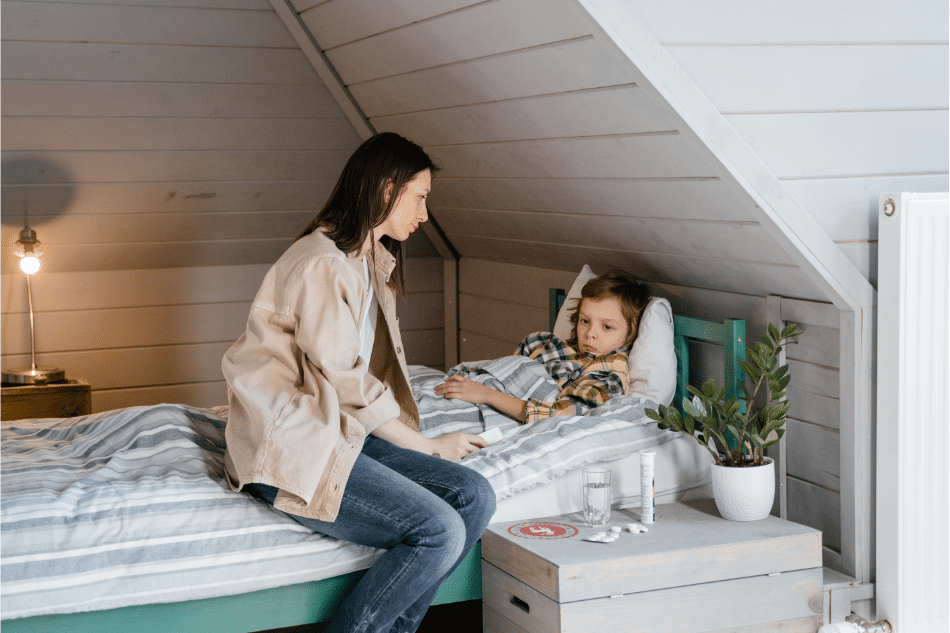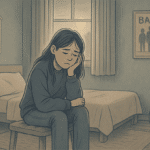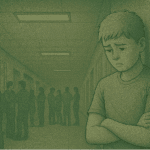Paroxetine (Paxil) for Teens: Everything You Need to Know

One in five teens in America experiences a mental health disorder every year, with anxiety and depression topping the bill.1 Treatment options have never been so in demand, and medications can be seen as a relatively quick and easy fix.
But with so many to choose from, how do you know which one is best for you? One name that often comes up is Paxil, but what is it? Is it safe? And what should you know before starting it?
On this page, we’re going to break down Paxil for teens, and answer some questions you might have, like:
- What is Paxil?
- How does it work?
- What is it used for in teens?
- How safe is it?
- What can I expect if I begin taking it?
- What can parents do to help their teenager on this journey?
Whether you’re a teen or a parent, keep reading to find out everything you need to know to make confident and well-informed decisions about your treatment.

What is Paxil?
Paxil is the brand name for an antidepressant medication called paroxetine. It is a selective serotonin reuptake inhibitor (SSRI), which means that it affects the level of a chemical called serotonin within the brain.
Serotonin is sometimes called a ‘good mood’ chemical because it has a positive effect on your mood, and it also plays a big role in your appetite and sleep. It is thought that people with mental health conditions like depression or anxiety have less serotonin than usual.
Paxil works in teen brains by helping your serotonin levels get back to healthy levels – the same as they would have been prior to when they were affected by a mental health condition. This can help to improve your mood and reduce other symptoms you may be having, which can make your daily life feel easier.2
What Does Paroxetine Treat in Teens?
Paroxetine can be used to treat a variety of issues in teens, not just major depressive disorder: You might take Paxil for teenage anxiety, obsessive-compulsive disorder (OCD), panic disorder, or social anxiety disorder.3 One big difference between Paxil and other SSRIs is that most patients find it makes them feel sleepy.4 So, if you’re a teen who struggles with sleepless nights and insomnia, Paxil may have the added benefit of working as a sleep aid.
Is Paxil Approved for Teenagers?
One question often comes to mind before starting a new treatment – is it safe and approved for use? We’re going to dive into different aspects of Paxil to see whether it is safe for teens to use, and if so, what for?
FDA Approval
Paroxetine is an FDA-approved antidepressant for adults to treat mental health issues such as depression, OCD, panic disorder, social anxiety disorder, generalized anxiety disorder (GAD), and posttraumatic stress disorder (PTSD).5 FDA approval means that the drug has been thoroughly tested in certain age groups for specific medical conditions, and has been found to meet strict requirements set by the U.S. Food and Drug Administration (FDA) as being a safe and effective treatment.
You’ll likely notice that it says approved for adults, as it has not been FDA approved for use in teens. However, medications do not need to be approved by the FDA to be safe and effective. The route to getting approval can be long and expensive, so some companies don’t seek approval for every condition or age group that their medication can treat. The medication can instead be used ‘off-label’, meaning it can be prescribed for a different use other than the FDA-specified one if there are studies and research to show the drug is safe and effective for off-label use.
Studies have been carried out into the safety of Paxil and its uses in treating teenagers for mental health conditions, and there is conflicting evidence and controversy around using it. Some research suggests that Paxil reduces depression symptoms in teens, however, it may also increase the risk of suicidal thoughts.6,7 Studies have also found Paxil to be great at tackling symptoms of OCD and anxiety in teens.8,9,10
However, one particular study found there was a significant increase in suicidal thoughts in teens taking paroxetine, and that it didn’t improve depression symptoms any better than taking a placebo sugar pill.11 No significant studies have been carried out in the last decade around Paxil in children, so it is best to weigh up your options carefully and to talk through medication risks and benefits with your doctor.
Suicidal Thoughts and Behaviors
Antidepressants come with a warning that people under 24 years old are at risk of having thoughts about harming themselves, or planning to do so, as a side effect of Paxil.5 If you begin taking Paxil, it’s important to be aware of this, especially in the first few weeks of treatment and when you increase the dose. If you start having thoughts of suicide or harming yourself, we recommend seeking immediate help and contacting your doctor.
Is Paxil Safe Long-Term in Teens?
We’ve just seen that there is an increased risk of suicidal thoughts and behaviors in teens taking Paxil, but what about things like brain development?
Well, the impact on brain development in teens taking SSRIs doesn’t have a clear answer due to a lack of studies.12 In addition, a team of researchers has potentially found some harmful side effects of paroxetine on the developing brain – it has the potential to suppress the growth of connection points between brain cells, which could affect development.13
When looking at long-term use of SSRIs in teens, again, there isn’t much research available. One study has suggested that long-term use of antidepressants in children could affect their growth and weight. However, more research is needed to really determine these risks.14
Paroxetine Teen Side Effects
All medications come with the potential for side effects, and Paroxetine is the same. These are temporary physical or mental changes that can be unpleasant. Around one in ten teens and children feel side effects from taking SSRIs, so it’s good to know what to expect.15
Some of the most common side effects of Paxil are:5
- Stomach issues, such as constipation, diarrhea, and nausea
- Appetite changes
- Dry mouth
- Yawning
- Nervousness
- Sweating
- Dizziness
- Sleepiness
- Sleep problems
- Changes to sexual functions
What Happens When You Start Paxil?
In the first week or two, you may experience some temporary side effects while the body gets used to a new medication being taken. Paxil takes roughly ten days to reach a steady state level in your body and brain, so you may start feeling some of the benefits, such as better mood and less anxiety, within a couple of weeks.5 However, it may take four to six weeks for you to feel the full benefit, as no two people react exactly the same to medication.
Paxil dosage in youth is usually decided by your doctor or mental health professional. It usually comes in tablet form, and you may start on a dose of 10mg per day for treating OCD, social anxiety, or panic disorder.3 As paroxetine can make you feel sleepy, your doctor may suggest taking it in the evening or at bedtime.4
Your doctor will be able to alter your dose based on side effects and getting the best results for your mental health. It can be a good idea to write down on a notepad or an app on your phone how you feel each day so that you can let your doctor know your progress.
Stopping Paxil in Adolescence
When you decide you’re ready to stop taking Paxil, it’s essential that you don’t just stop taking it suddenly. If you do this, you risk feeling some temporary and unpleasant mental and physical changes known as withdrawal effects. Common withdrawal symptoms of Paxil in teens can include:5
- Feeling like you have the flu (tired, headaches)
- Feeling sick
- Sweating
- Dizziness
- Sleep problems
- Tinnitus
- Feeling confused
- Low mood, crying, and suicidal thoughts
- Feeling irritable and agitated
- Anxiety
The risk of feeling this way is made less by gradually reducing the dose you are on over time, with the help of your doctor. They will be able to create a flexible plan with you for stopping paroxetine safely and as easily as possible, and you can have regular reviews to see how you are feeling at every stage.
How Parents Can Help Teens on Paxil
If you’re a parent wondering how you can help your teen on their treatment journey with Paxil, check out some of our top tips:
1. Medication Management
You can help your teen by making sure they take the right amount of Paxil when they need to, as it needs to build up in their system consistently to bring the benefits. You could also put their medication away when it’s not needed to prevent any accidental harm, especially if your teen has a history of self-harm or suicidal thoughts.
Finally, when it comes to medication management, try to be aware of the potential side effects so that you can help your teen through them.
2. Create a Supportive Space
Make home a safe space for them to talk about their feelings and how they are reacting to Paroxetine. Ask them questions and listen to them if they are unsure or concerned about something.
Encourage good lifestyle choices like a balanced diet, regular exercise, and getting enough sleep, as these can positively enhance their wellbeing and mood. Encourage them to pick up activities they enjoy, whether that’s sports, art, or reading.
3. Seek Professional Support
Ensure your teen attends doctor appointments for their reviews and treatment adjustments. Medication can be a great way to manage symptoms of depression and anxiety, but it doesn’t get to any underlying issues that may be keeping it going.
Talking therapy, such as cognitive behavioral therapy (CBT), can be a really effective treatment alongside Paxil. It will allow your teen to have a safe space to explore their feelings, discover and face any underlying patterns that may be making their condition worse, and then learn coping strategies to help them manage better.
Mission Prep offers a range of treatment services for teens experiencing mental health challenges, from medication management to therapy, and from 24/7 care to regular outpatient appointments.
Seek Support at Mission Prep Today
At Mission Prep, we know that working your way through mental health challenges can feel overwhelming, for both teens and their families. That’s why we’re here – to support you on your journey to recovery.
Mission Prep specializes in helping teens with their mental health. Mental health conditions can affect everyone differently, so we offer a wide range of treatment options to make sure that you are supported in the best way possible. Your care plan will be personalized to your individual needs to help you grow and thrive and can include medication management, therapy, and family support. Some of our treatment options include:
Residential Mental Health Treatment
– for round-the-clock care and support- Outpatient Mental Health Programs – such as CBT
- Intensive Outpatient Programs – for those wanting more support than traditional once-a-week therapy, but not needing support 24/7.
You don’t have to face mental health challenges alone. If you’re ready to take the next step toward better wellbeing, contact our team of mental health professionals today to find out how we can help you.

References
- Sappenfield, O., Alberto, C., Minnaert, J., Donney, J., Lebrun-Harris, L., & Ghandour, R. (2024, October 1). Adolescent mental and behavioral health, 2023. National Survey of Children’s Health Data Briefs – NCBI Bookshelf. https://www.ncbi.nlm.nih.gov/books/NBK608531/
- Miller, C. (2024, November 18). Medication for kids with depression. Child Mind Institute. https://childmind.org/article/medication-for-kids-with-depression/
- Shrestha, P., Fariba, K. A., & Abdijadid, S. (2023, July 17). Paroxetine. StatPearls – NCBI Bookshelf. https://www.ncbi.nlm.nih.gov/books/NBK526022/
- APA Dictionary of Psychology. (n.d.). https://dictionary.apa.org/paroxetine
- FDA. (1992). Highlights of prescribing information [Press release]. https://www.accessdata.fda.gov/drugsatfda_docs/label/2021/020031s077lbl.pdf
- Hetrick, S. E., McKenzie, J. E., Bailey, A. P., Sharma, V., Moller, C. I., Badcock, P. B., Cox, G. R., Merry, S. N., & Meader, N. (2021). New generation antidepressants for depression in children and adolescents: a network meta-analysis. Cochrane Library, 2021(5). https://doi.org/10.1002/14651858.cd013674.pub2
- Treatment of Depression in Children and Adolescents: A Systematic Review. (2020, April 1). PubMed. https://pubmed.ncbi.nlm.nih.gov/32298061/
- Geller, D. A., Wagner, K. D., Emslie, G., Murphy, T., Carpenter, D. J., Wetherhold, E., Perera, P., Machin, A., & Gardiner, C. (2004). Paroxetine Treatment in Children and Adolescents with Obsessive-Compulsive Disorder: A randomized, Multicenter, Double-Blind, Placebo-Controlled trial. Journal of the American Academy of Child & Adolescent Psychiatry, 43(11), 1387–1396. https://doi.org/10.1097/01.chi.0000138356.29099.f1
- Soomro, G. M. (2012, January 18). Obsessive compulsive disorder. https://pmc.ncbi.nlm.nih.gov/articles/PMC3285220/#BMJ_1004_I1182769070702
- Boaden, K., Tomlinson, A., Cortese, S., & Cipriani, A. (2020). Antidepressants in Children and Adolescents: Meta-Review of Efficacy, Tolerability and Suicidality in Acute Treatment. Frontiers in Psychiatry, 11. https://doi.org/10.3389/fpsyt.2020.00717
- Mani, N., MD. (2016, January 22). Anti-depressants for teens: A second look. Harvard Health. https://www.health.harvard.edu/blog/anti-depressants-for-teens-201601229018
- Cousins, L., & Goodyer, I. M. (2015). Antidepressants and the adolescent brain. Journal of Psychopharmacology, 29(5), 545–555. https://doi.org/10.1177/0269881115573542
- Antidepressant harms baby neurons in Lab-Grown “Mini-Brains.” (2021, July 24). Johns Hopkins Bloomberg School of Public Health. https://publichealth.jhu.edu/2020/antidepressant-harms-baby-neurons-in-lab-grown-mini-brains
- Murphy, S. E., Capitão, L. P., Giles, S. L. C., Cowen, P. J., Stringaris, A., & Harmer, C. J. (2021). The knowns and unknowns of SSRI treatment in young people with depression and anxiety: Efficacy, predictors, and mechanisms of action. The Lancet Psychiatry, 8(9), 824–835. https://doi.org/10.1016/s2215-0366(21)00154-1
- American Academy of Pediatrics. (n.d.). Antidepressants side effects: Pediatric mental health minute series. https://www.aap.org/en/patient-care/mental-health-minute/antidepressants-side-effects/



















